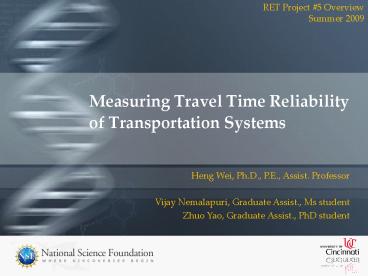Measuring Travel Time Reliability of Transportation Systems
1 / 8
Title:
Measuring Travel Time Reliability of Transportation Systems
Description:
... microsimulation, means that each entity (car, train, person) of reality that is ... Build a part of the freeway within VISSIM with the field data, including ... –
Number of Views:97
Avg rating:3.0/5.0
Title: Measuring Travel Time Reliability of Transportation Systems
1
Measuring Travel Time Reliability of
Transportation Systems
RET Project 5 Overview Summer 2009
Heng Wei, Ph.D., P.E., Assist. Professor Vijay
Nemalapuri, Graduate Assist., Ms student Zhuo
Yao, Graduate Assist., PhD student
2
Project 5 Overview Summer 2009
Overview
- Research experience in measuring mobility
reliability of a selected freeway (I-75). Such
reliability indices are quantified using
statistics and algebraic methods. - Advanced data collection technology using Global
Positioning System (GPS) Travel Recorder Data
Loggers. - Computer simulated learning made to understand
how to interact with informative feedback with
animation functionality and make decisions
without running risks through simulation running. - Field trip for better understanding of mobility
reliability with live observations in the
Cincinnati traffic information center (i.e.,
ARTIMIS). - Develop a lesson plan on the basic theme of
Transportation Impact on Your Community and
Daily Life? which introduces students to
analyzing impact of mobility on our daily life.
3
Methodology
Project 5 Overview Summer 2009
- Advanced data collection technology using Global
Positioning System (GPS) Travel Recorder Data
Loggers.
4
Methodology
Project 5 Overview Summer 2009
- Computer simulated learning will occur to
understand how to interact with informative
feedback with animation functionality and make
decisions without running risks through
simulation running.
Microscopic simulation, sometimes called
microsimulation, means that each entity (car,
train, person) of reality that is to be simulated
is simulated individually, i.e. it is represented
by a corresponding entity in the simulation,
thereby considering all relevant properties. The
same holds for the interactions between the
entities.
5
Methodology
Project 5 Overview Summer 2009
- Field trip will be scheduled for better
understand mobility reliability with live
observations in the Cincinnati traffic
information center.
ARTIMIS - The Advanced Regional Traffic
Interactive Management Information System
provides incident, congestion, and freeway
management for the Cincinnati-Northern Kentucky
Region. The project is funded by the Ohio
Department of Transportation (ODOT) and the
Kentucky Transportation Cabinet (KYTC) to improve
traffic conditions and safety along 88 miles of
the region's highways.
6
Tasks
Project 5 Overview Summer 2009
- Measure travel times and delays during morning
peak- and non-peak-hours along I-75 from the
Montgomery/Warren County Line to the
Montgomery/Miami County Line for three days - Use the field data to measure travel time
reliabilities with the techniques learned from
the training courses - Use SpeedInfo radar-based speed measurements
(provided by ODOT) to compare our individual
GPS-based observations - Use HCS to estimate the level of service of the
selected freeway facilities (work together with
REU team using volume data provided by OKI) - Build a part of the freeway within VISSIM with
the field data, including validation of the
simulation models, and visually simulate mobility
reliabilities under varied scenarios of traffic
volumes (inquire volume data from OKI for
comparison) - Summarize analysis results and develop classroom
implementation plan.
7
Timeline
Project 5 Overview Summer 2009
8
Resources
Project 5 Overview Summer 2009
Previous RET Experiences
- Computer Lab
- GPS data loggers
- GAs assistance
- Vijay Nemalapuri (RET GA)
- Zhuo Yao (RET GA)
- Zhixia Li (VISSIM training helper)
- Qingyi Ai (REU coordinator)
- Field trip (ARTIMIS)
- Faculties
QUESTIONS?































